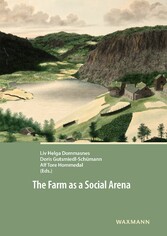Suchen und Finden
Service
Book Cover
1
Imprint
4
Preface
5
Contents
7
Introduction: The farm as a social arena (Liv Helga Dommasnes)
9
What is a farm?
10
Former research on the farm in Norway
11
Recent developments
13
The farm as a social arena
14
Papers and approaches
15
Why the farm?
19
Bibliography
20
Sheep, dog and man. Multi-species becomings leading to new ways of living in Early Bronze Age longhouses on Jæren, Norway (Kristin Armstrong Oma)
23
Abstract
23
Zusammenfassung
23
Changed way of living, changed way of building
24
Three-aisled longhouses – the research discourse of indoor stalling
25
Bronze Age house typology in relation to Rogaland houses
26
Finding a house shared by humans and animals
30
Did animals live in the Early Bronze Age houses of Rogaland?
31
Historical accounts of keeping sheep in Western Norway
34
Situating the Bronze Age farm in the wider environment
35
Faunal remains from Forsandmoen and Kvåle
36
Sheep in Bronze Age Europe – general trends
37
Wool textiles in graves
39
Primacy of sheep in Rogaland
40
Sheep and their social strategies
41
The domination discourse unbound
42
Trust, socialisation and habituation embedded in the architecture
43
Bibliography
46
Unlocking identities. Keys and locks from Iron Age farms in eastern Sweden (Emma Nordström)
53
Abstract
53
Zusammenfassung
53
Introduction
54
Material, method and outline of the study
55
Vallhagar
57
Granby-Hyppinge
63
Locked doors and chests in the Icelandic Sagas
67
The keys to the farm
70
Unlocking identities
72
Acknowledgements
73
Understandings – burial practice, identity and social ties. The Horvnes Iron Age burials, a peephole into the farming society of Helgeland, North-Norway (Birgitta Berglund)
77
Abstract
77
Zusammenfassung
77
The puzzling Horvnes burials
78
The Horvnes burials and the farming society
79
The magnate farm Sandnes
80
The Horvnes graves: Burial practices, analyses and presentations of the buried individuals
83
The Horvnes East grave: burial practices, analyses and presentations of the buried individuals
91
Towards a new understanding of the Horvnes burials
96
New perspectives of the Iron Age farming society and burial customs at the coast of Helgeland
101
Acknowledgements
102
Bibliography
102
Individual lifeworlds and social structured societies in Merovingian settlements from the Munich Gravel Plain (Doris Gutsmiedl-Schümann)
105
Abstract
105
Zusammenfassung
105
Introduction
105
Farms and settlements
108
The main source for social structure of early medieval society: Graves
116
Contemporary written sources
119
Conclusion and closing remarks
120
Bibliograhpy
121
One thousand years of tradition and change on two West-Norwegian farms AD 200–1200 (Liv Helga Dommasnes and Alf Tore Hommedal)
127
Abstract
127
Zusammenfassung
127
Introduction
127
The monuments
134
Becoming European
144
Tradition, change and bases of power
152
Some conclusions
161
Bibliography
163
A shattered farm: Changes in making space from pagan to Christian Norway (Kristin Armstrong Oma)
171
Abstract
171
Zusammenfassung
171
From pagan to Christian farms
172
From space to place
172
Animals and their changing ontological status
179
Posthumanism – or prehumanism? Animals in the pagan Norse universe
181
From pagan to Christian – changes in ontological status
183
Animals in the early Christian theology
183
Changes in the nature of being?
184
Bibliography
187
House, farmyard and landscape as social arena in a time of transition (Helge Sørheim)
191
Abstract
191
Zusammenfassung
191
Research focus and approaches
192
What creates the social character?
192
Iron Age and Medieval houses and farm in Norway, a short review
193
Tradition, conservatism? – why was the corner-timbering technique not used earlier?
196
Routines, rituals, habitus
198
Territories, space, home and building tradition
199
Borders, roles
200
The house and social levels
202
Interior of the house
204
The new farm plan
207
The towns
209
Conclusion
210
Between chiefdom and kingdom. A case study of the Iron Age farm Borg in Lofoten, Arctic Norway (Inger Storli)
219
Abstract
219
Zusammenfassung
219
Introduction: Borg farm and its people
219
Some comments on archaeology and archaeologists
221
The archaeology of Borg
223
Borg I
224
Rich farms and their location
227
Court sites in Lofoten
230
The hall and its meaning
232
A possible high seat
234
On the scent of a line of princes?
236
From Borg to Iceland?
238
Borg between chiefdom and kingdom
239
Bibliography
240
Constructing society in Viking Age Iceland: Rituals and power (Timothy Carlisle and Karen Milek)
245
Abstract
245
Zusammenfassung
245
Introduction
246
The role of ritual performance in Viking Age belief systems
248
Possible structured house deposits at Aðalstræti 16, Reyjkjavík
252
Possible structured house deposits at Hofstaðir, Mývatnssveit
256
Possible structured house deposit at Vatnsfjörður, Westfjords
259
Structured house deposits in a social perspective
262
Conclusions: Structured house deposits, domestic space, and society
265
Bibliography
266
The social structures of High Medieval rural settlements. An example from the Northern Rhineland, Germany (Timo Bremer)
273
Abstract
273
Zusammenfassung
274
Introduction
275
The rural space of the northern Rhineland in the High Middle Ages
277
Archaeological excavations in Pier, its backcountry and the environment
279
The settlement formation in the research area before the High Middle Ages
280
High Medieval settlement structures in Pier
283
Sociological interpretation of the High Medieval features
289
Conclusions
292
Bibliography
293
“Being a vicar at the end of the world”. The priesthood at Alstahaug vicarage in North-Norway presents its identity through the household and daily life before AD 1750 (Birgitta Berglund)
297
Abstract
297
Zusammenfassung
297
The approach
298
Archaeological excavations and written sources
301
How did the priesthood present itself through the delights of the table?
304
Cooking pots and pans
308
How did the priesthood present itself through personal items?
314
How did the priesthood present itself through the buildings?
316
Concluding remarks and perspectives – presenting, producing and maintaining identity
318
Epilogue
320
Bibliography
320
Authors and editors
323
Alle Preise verstehen sich inklusive der gesetzlichen MwSt.








